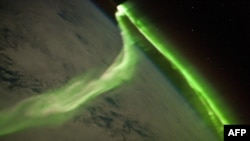The U.S. Space Weather Prediction Center has issued a warning for a strong geomagnetic storm Saturday, saying power and communications systems could be affected in the Northern Hemisphere after a significant solar flare was observed on the sun.
In a statement on its website, the agency said G3, or strong geomagnetic storm conditions, were observed from 0900 to 1200 UTC Friday.
A geometric storm, the agency says, is "a stronger disturbance in the Earth's magnetic field, often varying in intensity over the course of some hours."
The agency said the increase in geomagnetic activity was primarily caused by a coronal mass ejection (CME) from the sun associated with a moderate solar flare observed Tuesday, which joined several other lesser CMEs that were already headed toward Earth.
CMEs are powerful eruptions on the sun's surface that send tons of superheated gas and radiation into space.
These often head toward Earth, and while harmful radiation from a flare cannot pass through Earth's atmosphere to physically affect humans, if the flare is strong enough, it can disturb the layer in the atmosphere where GPS and other communication signals travel.
The agency said it has alerted infrastructure operators, such as power companies, to take precautions to mitigate any possible effects.
The strong geomagnetic storm warning is valid through late Friday, with G1, or minor geomagnetic storms expected through Saturday.
The effect from the geomagnetic storm most noticeable to the general public could be the aurora borealis, also known as the northern lights.
The Washington Post said Friday that colorful auroras were reported at least as far south as the southwestern state of Arizona in the United States, with vibrant displays reported at higher latitudes.
Reports of auroras from Australia were posted on social media as well.









